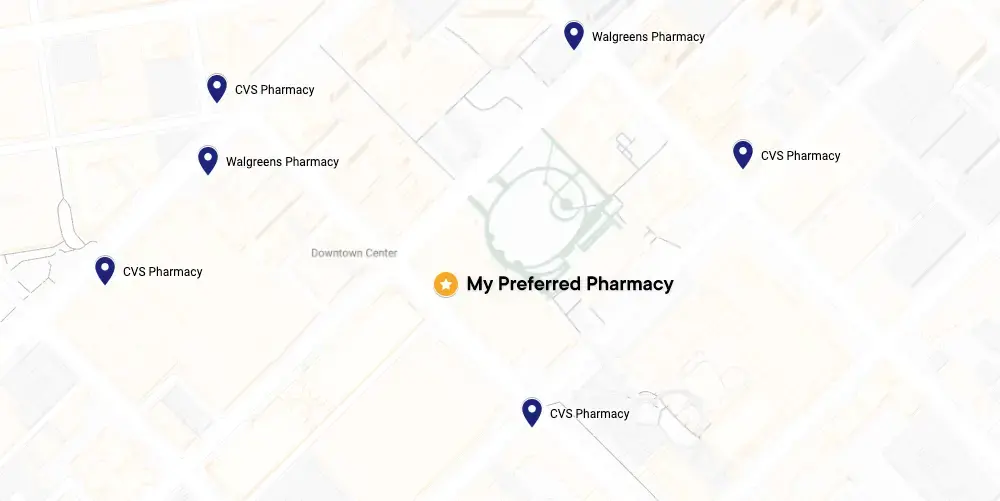People with bipolar disorder appear to have some subtle but detectable changes in their brain structures.

Online bipolar treatment available today
Treatment of bipolar disorder will depend on symptoms, age and the severity of impact. While PlushCare does not have online psychiatrists to treat patients, our Collaborative Care Model includes Psychiatric Consultants and allows our primary care physicians to diagnose and treat some types of BD.*
*Prescriptions are provided at the doctor's discretion. Learn more about our controlled substances policy and how to save up to 80% with our prescription discount card. PlushCare doctors cannot treat all cases of bipolar disorder. Our primary care physicians can conduct an initial evaluation of your symptoms but may need to refer you to a specialist or for in-person treatment. If you are experiencing life-threatening symptoms, seek emergency medical attention immediately.
Learn about bipolar disorder (BD)
Bipolar disorder is a mental illness that causes extreme shifts in mood, energy, activity levels, and behaviors. People with bipolar disorder typically experience mood episodes that can be categorized as manic/hypomanic (emotionally high) and depressive (emotionally low) moods. These manic episodes (or depressive episodes) can last from hours to months and affect sleep, energy, activity, behavior and mental acuity.
If left untreated, bipolar disorder can be detrimental to your health and the wellbeing of those around you. Treating this condition early and effectively is the key to living a normal life. According to the American Psychiatric Association, when properly diagnosed and treated , bipolar disorder is completely manageable, and people with bipolar disorder can go on and live normal and productive lives.
According to the National Institute of Health, there are 4 different types of bipolar disorder:
-
Bipolar I disorder
-
Bipolar II disorder
-
Cyclothymic disorder
-
Other specified and unspecified bipolar and related disorders
Bipolar disorder causes
The exact cause of bipolar disorder is still an area of active scientific research, but scientist think several factors can contribute to bipolar disorder:
Biological differences
Environmental factors
High stress and traumatic events (e.g. death in family) can trigger a manic or depressive episode.
Genetics
People with bipolar disorder seem to have at least one close biological relative with similar condition. However, it should be noted that if you have a relative with bipolar disorder, it does not necessarily mean that you will develop bipolar disorder. Scientists are still in trying to identify the genes that may be involved in triggering bipolar disorder.
Bipolar disorder symptoms
According to the National Institute of Health, there are various types of bipolar disorder:
-
Bipolar I disorder - People diagnosed with bipolar I disorder have experienced manic episodes that lasted at least seven days or are so severe that requires hospitalization. A person can also suffer a major depressive episodes with each lasting at least two weeks
-
Bipolar II disorder - People with bipolar II disorder experience depressive episodes and hypomanic episodes, but not as severe as those in bipolar I disorder.
-
Cyclothymic disorder - People with cyclothymic disorder have a chronically unstable mood state. They experience shifting hypomania and mild depression episodes for at least two years.
Below we describe the manic symptoms and the depressive symptoms.
Manic episodes and hypomanic episodes
A mania episode is much more severe than hypomanic episode. It can trigger a break from reality (psychosis) and require hospitalization. Both types of episodes include these manic symptoms of bipolar disorder:
-
abnormally happy, excited
-
restlessness
-
increased energy
-
decreased sleep
-
rapid speech
-
poor decision making
-
psychotic symptoms of bipolar disorder such as hallucinations and delusions
Depressive episodes
Depressive symptoms of bipolar disorder can include the following:
-
Depressed mood, such as overwhelming sadness
-
Low energy
-
No motivation
-
Irritability
-
decreased sleep
-
thoughts of death or suicide
How to treat bipolar disorder
Please note that while we do not have online psychiatrists at this time and therefore cannot diagnose bipolar disorder, our primary care physicians may be able to refill prescriptions to treat bipolar disorder. Our board-certified online physicians can refer you to one of our therapists for further treatment, as well as a psychiatrist for in-person medication management of bipolar disorder.
Bipolar medication
Common bipolar disorder medications can include the following:
Taken to control manic or hypomanic episodes.
-
Mood stabilizers - taken to control manic or hypomanic episodes. Examples of mood stabilizers are Lamotrigine (Lamictal) and lithium (Eskalith)
-
Second-generation neuroleptics - these are antipsychotic medications. Examples are Seroquel (antipsychotic), Abilify (antipsychotic) and Latuda (antipsychotic)
Antidepressants
Some bipolar patients may be able to manage symptoms with certain antidepressants if prescribed and monitored by a psychiatrist. Doctors have to prescribe antidepressant medication together with mood stabilizing medication to prevent triggering a manic episode.
Managing bipolar disorder
Bipolar disorder is a long term mental health condition that requires continuous treatment to help manage the symptoms. In addition to medication, a patient can work with a mental health professional to receive psychotherapy (talk therapy) to help with the stresses of mood swings. There are a few psychotherapy options:
-
Cognitive behavioral therapy (CBT): During a session, a mental health professional will work with you to identify the negative thoughts/behaviors that trigger the episodes, and replacing them with healthy, positive ones. With time, you will develop effective coping strategies.
-
Family-focused therapy: During a session, a mental health professional will help you and your family recognize warning signs of mood swings and develop effective management strategies as a family. Family focused therapy can be highly effective.
Electroconvulsive therapy (ECT) is another treatment option. During a treatment session, electrical currents are passed through the brain to try and alter brain chemistry to help alleviate some of the symptoms.
When to see a doctor for bipolar disorder
Note that thoughts death and suicides are common among people with bipolar disorder. If you are thinking of hurting yourself, call 911 or your local emergency number immediately.
Related conditions to bipolar disorder
Anxiety
An anxiety disorder is a mental health disorder characterized by debilitating feelings of anxiety or fear. Some studies have shown that many patients with bipolar disorder also suffer from at least one anxiety disorder, or will develop at least one at some point.
Depression
Patients suffering from bipolar disorder will undergo depressive episodes.
OCD
Obsessive-Compulsive Disorder, OCD, is an anxiety disorder. A person suffering from OCD will have recurrent, unwanted thoughts (obsessions) and/or repetitive behaviors (compulsions). Some studies have shown that many patients with bipolar disorder also tend to suffer from OCD concurrently.
ADHD
Attention-deficit/hyperactivity disorder (ADHD) is a mental health condition that is characterized by chronic problems including difficulty paying attention and acting hyperactively or impulsively. Some symptoms of ADHD, such as impulsivity and inattention, can overlap with bipolar disorder. Some patients with bipolar disorder also suffer from ADHD.
PTSD
Posttraumatic stress disorder, PTSD, is an anxiety disorder. A person suffering from PTSD had undergone/witnessed a traumatic event, and will suffer intense anxiety when triggered. Some studies have shown that many patients with bipolar disorder also tend to suffer from PTSD concurrently.
Bipolar disorder treatment and medication FAQs
What is the best treatment for bipolar disorder?
The best treatment for bipolar disorder is a combination of medication and psychotherapy.
What is the best medication for bipolar disorder?
Depending on the type of bipolar disorder and also the severity of your symptoms, your doctor will prescribe the appropriate medicine. Doctors have to prescribe antidepressant medication together with mood stabilizing medication to prevent triggering a manic episode.
Can bipolar be cured without medication?
No. Bipolar disorder doesn't go away and require a formal diagnosis. If you develop any symptoms of depression or mania, see your doctor or mental health professional for help. With a professionally formulated treatment plan, you can minimize disruptions to your lifestyle.
How can a person tell if they are bipolar?
Many times, people with bipolar disorder fail to recognize how much their mood swings disrupt their lives and those close to them. If you develop any symptoms of depression or mania, see your doctor or mental health professional to get a formal diagnosis.
Can bipolar disorder be cured permanently?
Unfortunately, bipolar disorder cannot be cured permanently. Bipolar disorder is a long term mental health condition that requires continuous treatment to help manage the symptoms. With the right combination of medication and therapy, many patients can continue to have normal lives.
3 simple steps to request treatment for bipolar disorder online

Book a bipolar disorder treatment appointment.

Talk to your medical provider regarding your bipolar symptoms.

If prescribed, pick up a prescription to help treat bipolar disorder.
Bipolar disorder treatment pricing details
To request bipolar disorder treatment or refill on your prescription, join our monthly membership and get discounted visits
30 days of free membership
- Same-day appointments 7 days a week
- Unlimited messages with your Care Team
- Prescription discount card to save up to 80%
- Exclusive discounts on lab tests
- Free memberships for your family
- Cancel anytime
Paying with insurance
Membership
$19.99
First month free
Visits
Copay
Visit price with insurance
Often the same as an office visit. Most patients with in-network insurance pay $30 or less!
We accept these insurance plans and many more:



Paying without insurance
Membership
$19.99
First month free
Visits
$129
Visit price without insurance
Bipolar disorder treatment resources
Sources:
PlushCare is dedicated to providing you with accurate and trustworthy health information.
-
American Psychiatric Association. "What Are Bipolar Disorders?" Psychiatry.org, Accessed on October 10, 2023, https://www.psychiatry.org/patients-families/bipolar-disorders/what-are-bipolar-disorders.
-
National Institute of Mental Health. "Bipolar Disorder." NIMH, Accessed on October 10, 2023, https://www.nimh.nih.gov/health/topics/bipolar-disorder.
-
Mayo Clinic Staff. "Bipolar Disorder." Mayo Clinic, Accessed on October 10, 2023, https://www.mayoclinic.org/diseases-conditions/bipolar-disorder/symptoms-causes/syc-20355955.
-
Cleveland Clinic. "Bipolar Disorder." Cleveland Clinic, Accessed on October 10, 2023, https://my.clevelandclinic.org/health/diseases/9294-bipolar-disorder.
PlushCare content is reviewed by MDs, PhDs, NPs, nutritionists, and other healthcare professionals. Learn more about our editorial standards and meet the medical team. The PlushCare site or any linked materials are not intended and should not be construed as medical advice, nor is the information a substitute for professional medical expertise or treatment.